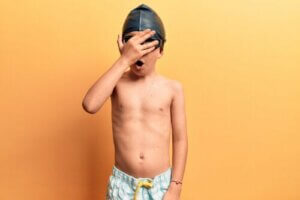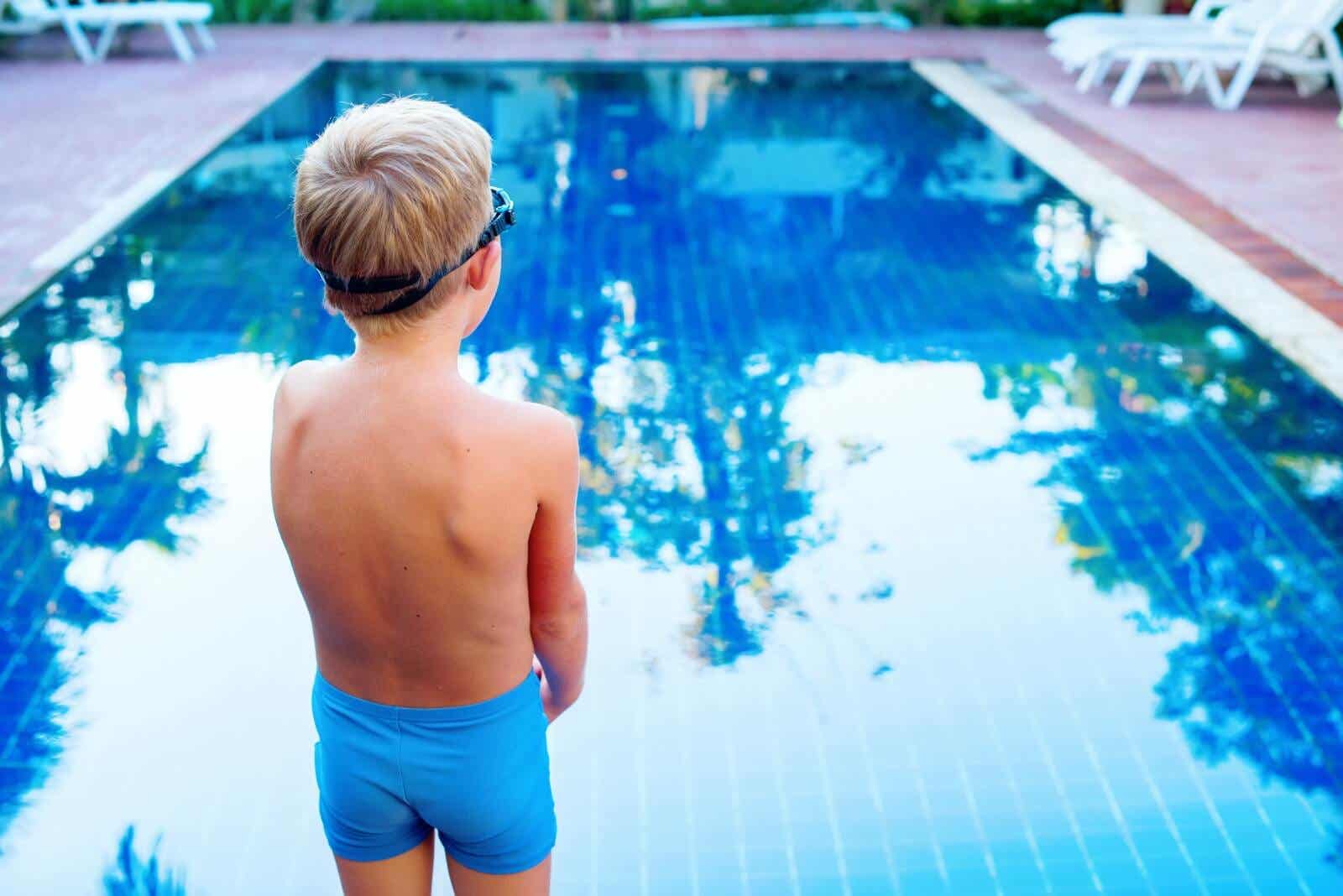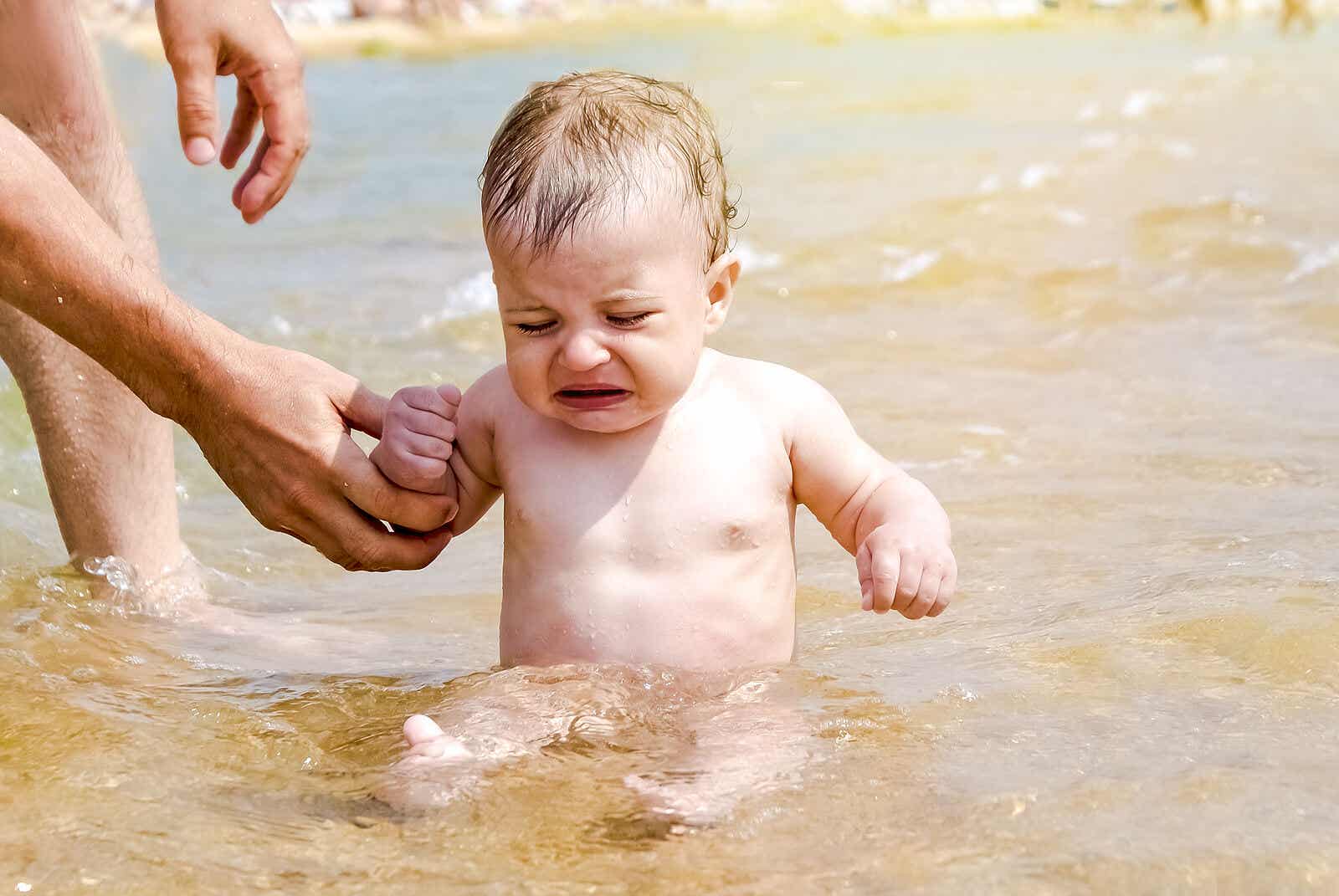Hydrophobia in Children: How to Handle It?


Written and verified by the psychologist Elena Sanz Martín
With the arrival of summer, lakes, rivers, beaches, and swimming pools become our best leisure alternatives. Children, for the most part, consider water to be a source of fun and new experiences. However, for those who suffer from hydrophobia, approaching water can be a great source of anxiety and discomfort. Hydrophobia in children manifests itself in a little one’s first encounters with large areas of water. But it can also happen that a child who previously enjoyed playing with water develops this irrational fear, to the bewilderment and despair of their parents.
So how can we help?
What is hydrophobia in children?
Hydrophobia is an irrational and disproportionate fear of water or of coming into contact with it. The symptoms of hydrophobia in children are those of any other specific phobia:

- Intense, excessive, and persistent fear when coming into contact with water or at the thought of this happening.
- Experiencing physiological symptoms, such as tachycardia, shortness of breath, restlessness, muscle tension, or psychosomatic pain.
- Negative and dysfunctional thoughts about the dangers of being around water.
- The child avoids contact with water in any way they can, resisting, crying, and running in the opposite direction.
- If contact with water hasn’t been avoided, the child experiences tremendous discomfort and tries to escape from the situation as quickly as possible.
- This situation continues over a long period of time.
Where does this fear arise from?
First of all, we have to take into account that, when children are young and approach pools or large bodies of water for the first time, it’s common for them to feel fear. It’s an unknown and evolutionarily dangerous environment, especially when the child doesn’t yet know how to swim. Therefore, to be considered a phobia, the fear must be prolonged and excessive.
At the same time, the origin of the phobia may not be clear and it’s possible for different factors to converge. Even so, it’s likely that some of the following situations could have triggered this irrational fear:
- First-person traumatic experiences with water. Any past event in which the child has felt at risk in an aquatic environment can trigger the phobia. Therefore, it’s possible for a young child who was a natural in the water to develop this fear after an accident in which they felt they were drowning or if they were introduced to the water abruptly.
- Vicarious conditioning. That is, having witnessed an unpleasant event experienced by another person in the water.
- Fearful education. On many occasions, it’s common for the child’s fear to be induced by their parents’ own fears and what they’ve transmitted to their child. If you talk to your child about water as something dangerous, they’ll incorporate this information even without having had any bad experience.

How to deal with hydrophobia in children?
For parents, it can be difficult to understand and deal with hydrophobia in children. For the same reason, on many occasions, our good intentions translate into inadequate actions.
Therefore, it’s important not to belittle your children’s fear or try to downplay or ridicule them for it. It’s necessary to validate what they feel and accompany them with understanding and patience in the process of overcoming their fear.
As in the treatment of any phobia, the most effective technique is gradual exposure to the feared stimulus, in this case, water. We must encourage children to approach water progressively and, preferably, in a playful, fun, and carefree environment.
In the case of adults, it’s common to use relaxation techniques to induce a state that’s incompatible with the anxiety that allows them to face this exposure in a better way. In the case of children, play replaces relaxation. This way, while they’re having fun and enjoying themselves, the appearance of fear isn’t possible.
At the same time, it’s also very positive to have models that allow children to see how others relate to water with pleasure and without fear. This is especially helpful when the models are other children. Ultimately, changing their perception of water and helping them to deal with fear gradually will be the best alternative.
With the arrival of summer, lakes, rivers, beaches, and swimming pools become our best leisure alternatives. Children, for the most part, consider water to be a source of fun and new experiences. However, for those who suffer from hydrophobia, approaching water can be a great source of anxiety and discomfort. Hydrophobia in children manifests itself in a little one’s first encounters with large areas of water. But it can also happen that a child who previously enjoyed playing with water develops this irrational fear, to the bewilderment and despair of their parents.
So how can we help?
What is hydrophobia in children?
Hydrophobia is an irrational and disproportionate fear of water or of coming into contact with it. The symptoms of hydrophobia in children are those of any other specific phobia:

- Intense, excessive, and persistent fear when coming into contact with water or at the thought of this happening.
- Experiencing physiological symptoms, such as tachycardia, shortness of breath, restlessness, muscle tension, or psychosomatic pain.
- Negative and dysfunctional thoughts about the dangers of being around water.
- The child avoids contact with water in any way they can, resisting, crying, and running in the opposite direction.
- If contact with water hasn’t been avoided, the child experiences tremendous discomfort and tries to escape from the situation as quickly as possible.
- This situation continues over a long period of time.
Where does this fear arise from?
First of all, we have to take into account that, when children are young and approach pools or large bodies of water for the first time, it’s common for them to feel fear. It’s an unknown and evolutionarily dangerous environment, especially when the child doesn’t yet know how to swim. Therefore, to be considered a phobia, the fear must be prolonged and excessive.
At the same time, the origin of the phobia may not be clear and it’s possible for different factors to converge. Even so, it’s likely that some of the following situations could have triggered this irrational fear:
- First-person traumatic experiences with water. Any past event in which the child has felt at risk in an aquatic environment can trigger the phobia. Therefore, it’s possible for a young child who was a natural in the water to develop this fear after an accident in which they felt they were drowning or if they were introduced to the water abruptly.
- Vicarious conditioning. That is, having witnessed an unpleasant event experienced by another person in the water.
- Fearful education. On many occasions, it’s common for the child’s fear to be induced by their parents’ own fears and what they’ve transmitted to their child. If you talk to your child about water as something dangerous, they’ll incorporate this information even without having had any bad experience.

How to deal with hydrophobia in children?
For parents, it can be difficult to understand and deal with hydrophobia in children. For the same reason, on many occasions, our good intentions translate into inadequate actions.
Therefore, it’s important not to belittle your children’s fear or try to downplay or ridicule them for it. It’s necessary to validate what they feel and accompany them with understanding and patience in the process of overcoming their fear.
As in the treatment of any phobia, the most effective technique is gradual exposure to the feared stimulus, in this case, water. We must encourage children to approach water progressively and, preferably, in a playful, fun, and carefree environment.
In the case of adults, it’s common to use relaxation techniques to induce a state that’s incompatible with the anxiety that allows them to face this exposure in a better way. In the case of children, play replaces relaxation. This way, while they’re having fun and enjoying themselves, the appearance of fear isn’t possible.
At the same time, it’s also very positive to have models that allow children to see how others relate to water with pleasure and without fear. This is especially helpful when the models are other children. Ultimately, changing their perception of water and helping them to deal with fear gradually will be the best alternative.
All cited sources were thoroughly reviewed by our team to ensure their quality, reliability, currency, and validity. The bibliography of this article was considered reliable and of academic or scientific accuracy.
- Carrero, M. (2018, 11 septiembre). Hidrofobia, el miedo al agua. Recuperado julio de 2020, de https://lamenteesmaravillosa.com/hidrofobia-el-miedo-al-agua/
- Abadía, O., Aumente, M., Salguero, A., & Tuero, C. (1998). La hidrofobia: Una experiencia práctica. Recuperado julio de 2020, de https://es.scribd.com/document/149902453/La-Hidrofobia
This text is provided for informational purposes only and does not replace consultation with a professional. If in doubt, consult your specialist.








